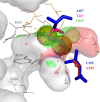Regiospecific Oxidation of Chlorobenzene to 4-Chlororesorcinol, Chlorohydroquinone, 3-Chlorocatechol and 4-Chlorocatechol by Engineered Toluene o-Xylene Monooxygenases
- PMID: 35736230
- PMCID: PMC9275245
- DOI: 10.1128/aem.00358-22
Regiospecific Oxidation of Chlorobenzene to 4-Chlororesorcinol, Chlorohydroquinone, 3-Chlorocatechol and 4-Chlorocatechol by Engineered Toluene o-Xylene Monooxygenases
Abstract
Toluene o-xylene monooxygenase (ToMO) was found to oxidize chlorobenzene to form 2-chlorophenol (2-CP, 4%), 3-CP (12%), and 4-CP (84%) with a total product formation rate of 1.2 ± 0.17 nmol/min/mg protein. It was also discovered that ToMO forms 4-chlorocatechol (4-CC) from 3-CP and 4-CP with initial rates of 0.54 ± 0.10 and 0.40 ± 0.04 nmol/min/mg protein, respectively, and chlorohydroquinone (CHQ, 13%), 4-chlororesorcinol (4-CR, 3%), and 3-CC (84%) from 2-CP with an initial product formation rate of 1.1 ± 0.32 nmol/min/mg protein. To increase the oxidation rate and alter the oxidation regiospecificity of chloroaromatics, as well as to study the roles of active site residues L192 and A107 of the alpha hydroxylase fragment of ToMO (TouA), we used the saturation mutagenesis approach of protein engineering. Thirteen TouA variants were isolated, among which some of the best substitutions uncovered here have never been studied before. Specifically, TouA variant L192V was identified which had 1.8-, 1.4-, 2.4-, and 4.8-fold faster hydroxylation activity toward chlorobenzene, 2-CP, 3-CP, and 4-CP, respectively, compared to the native ToMO. The L192V variant also had the regiospecificity of chlorobenzene changed from 4% to 13% 2-CP and produced the novel product 3-CC (4%) from 3-CP. Most of the isolated variants were identified to change the regiospecificity of oxidation. For example, compared to the native ToMO, variants A107T, A107N, and A107M produced 6.3-, 7.0-, and 7.3-fold more 4-CR from 2-CP, respectively, and variants A107G and A107G/L192V produced 3-CC (33 and 39%, respectively) from 3-CP whereas native ToMO did not. IMPORTANCE Chlorobenzene is a commonly used toxic solvent and listed as a priority environmental pollutant by the US Environmental Protection Agency. Here, we report that Escherichia coli TG1 cells expressing toluene o-xylene monooxygenase (ToMO) can successfully oxidize chlorobenzene to form dihydroxy chloroaromatics, which are valuable industrial compounds. ToMO performs this at room temperature in water using only molecular oxygen and a cofactor supplied by the cells. Using protein engineering techniques, we also isolated ToMO variants with enhanced oxidation activity as well as fine-tuned regiospecificities which make direct microbial oxygenations even more attractive. The significance of this work lies in the ability to degrade environmental pollutants while at the same time producing valuable chemicals using environmentally benign biological methods rather than expensive, complex chemical processes.
Keywords: chlorobenzene; microbial oxidation; protein engineering; saturation mutagenesis; toluene o-xylene monooxygenase.
Conflict of interest statement
The authors declare no conflict of interest.
Figures

References
-
- Agency for Toxic Substances and Disease Registry (ATSDR). 2017. Agency for Toxic Substances and Disease Registry’s Substance Priority List. ATSDR, US Department of Health and Human Services, Washington, DC. Available from https://www.atsdr.cdc.gov/spl/index.html.
-
- Larrañaga MD, Lewis RJ, Lewis RA. 2016. Hawley’s condensed chemical dictionary, 16th edition. John Wiley & Sons, Inc., Hoboken, NJ.
-
- U.S. Environmental Protection Agency. 2009. National Primary Drinking Water Regulations, p 7. US EPA, Washington, DC. Available from https://www.epa.gov/sites/production/files/2016-06/documents/npwdr_compl....
-
- Beck U, Löser E. 2011. Chlorinated benzenes and other nucleus-chlorinated aromatic hydrocarbons. Ullmann’s encyclopedia of industrial chemistry, Wiley-VCH Verlag GmbH & Co, Weinheim, Germany.
Publication types
MeSH terms
Substances
Grants and funding
LinkOut - more resources
Full Text Sources
Miscellaneous

